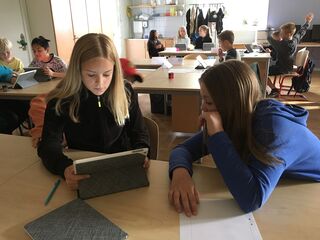How Finland Fights Disinformation: A Model for Media Literacy Training at Any Age.
2022-06-07 09:41

by Susan A. Nolan, Ph.D., and Michael Kimball (Misinformation Desk)-psychologytoday
KEY POINTS
- Finland has a country-wide media literacy program at all levels of education.
- Research suggests that misinformation-related education works; Finland is the top European country for media-related critical thinking.
- Research in Uganda suggests that such training can work even in low-resource contexts.
- The United States could benefit from evidence-based curricula aimed at media literacy.

Educators in Finland tackle misinformation, disinformation, and malinformation in the classroom across all ages.
Source: Sofiapedagog/Wikimedia Commons
“Fairytales work well,” Finish educator Kari Kivinen explained in an interview with The Guardian. Kivinen is talking about pedagogy aimed at developing critical thinking in young people. He continued, “Take the wily fox who always cheats the other animals with his sly words. That’s not a bad metaphor for a certain kind of politician, is it?”
This educational model, developed in Finland, teaches young students to push back against “fake news” as early as primary school. The Finnish government began this pedagogical push in 2014 when Russian disinformation became increasingly widespread in Finland.
Such a program is increasingly necessary, Kivinen notes, as Finnish children, like their counterparts around the world, consume news not from traditional sources, but from social media, including WhatsApp, Instagram, and Snapchat. He further highlights the central role of algorithms in determining what news young people see and emphasizes the importance of instilling a critical eye in children as they consume information pushed by social media.
Early Media Literacy Education Works
Research suggests that Finland’s initiative is well-timed. Belief in conspiracy theories seems to start around age 14, so why not lay the groundwork for appropriate skepticism sooner?
But does such early education work? In a word, yes. Finland is overwhelmingly the top country in the European Media Literacy Index. The report described Finland and other high-scoring countries as “best equipped to withstand the impact of fake news due to the quality of education, free media, and high trust among people.” This early media education is an essential part of Finland’s success.
Finland is a wealthy country, so you might wonder if such success requires certain resources. That is not the case, as two randomized controlled trials in Uganda suggest. After two days of training, Ugandan teachers gave a series of nine lessons on information literacy related to health outcomes to children aged 10-12 years old. The researchers reported a “large improvement” in children’s information literacy related to health. They concluded that “it is possible to teach primary school children to think critically in schools with large student-to-teacher ratios and few resources.”
article continues after advertisement
Don’t Call It “Fake News”
The Finnish educator Kivinen explains that he avoids the term “fake news” for children, and emphasizes the breakdown of misinformation, disinformation, and "malinformation" that we wrote about previously. Misinformation includes errors that may be unintentional. Disinformation encompasses outright lies. And malinformation is what Kivinen terms “gossip.” Malinformation may be accurate or inaccurate; either way, the goal is to cause harm. “Even quite young children can grasp this,” Kivinen said about this breakdown. “They love being detectives.”
The world should look to Finland—as well as Uganda—as a model. As the Open Society Institute observes “educational approaches [are] the best vaccination strategy to fake news.” There are a number of efforts at misinformation-related education at the university level in the United States, but there are few widespread attempts to teach younger students about these issues. One possible exception is Checkology, an initiative of the U.S.-based nonpartisan organization News Literacy Project. With ready resources, hopefully, policymakers will add this important content to the primary and secondary school curricula. This doesn’t have to be a fairytale.
References
Bermudez, L. G., Grilo, S. A., Santelli, J. S., & Ssewamala, F. M. (2017). Informing health choices in low-resource settings. The Lancet, 390(10092), 336-338. https://doi.org/10.1016/S0140-6736(17)31290-4
Jolley, D., Douglas, K. M., Skipper, Y., Thomas, E., & Cookson, D. (2021). Measuring adolescents’ beliefs in conspiracy theories: Development and validation of the Adolescent Conspiracy Beliefs Questionnaire (ACBQ). British Journal of Developmental Psychology, 39(3), 499-520. https://doi.org/10.1111/bjdp.12368









